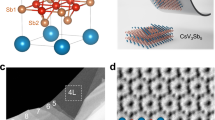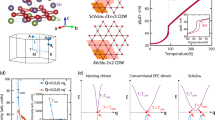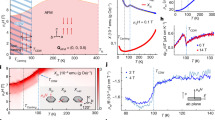Abstract
Discoveries of ratios whose values are constant within broad classes of materials have led to many deep physical insights. The Kadowaki–Woods ratio (KWR; refs 1, 2) compares the temperature dependence of a metal’s resistivity to that of its heat capacity, thereby probing the relationship between the electron–electron scattering rate and the renormalization of the electron mass. However, the KWR takes very different values in different materials3,4. Here we introduce a ratio, closely related to the KWR, that includes the effects of carrier density and spatial dimensionality and takes the same (predicted) value in organic charge-transfer salts, transition-metal oxides, heavy fermions and transition metals—despite the numerator and denominator varying by ten orders of magnitude. Hence, in these materials, the same emergent physics is responsible for the mass enhancement and the quadratic temperature dependence of the resistivity, and no exotic explanations of their KWRs are required.
This is a preview of subscription content, access via your institution
Access options
Subscribe to this journal
Receive 12 print issues and online access
$259.00 per year
only $21.58 per issue
Buy this article
- Purchase on SpringerLink
- Instant access to full article PDF
Prices may be subject to local taxes which are calculated during checkout


Similar content being viewed by others
References
Rice, M. J. Electron–electron scattering in transition metals. Phys. Rev. Lett. 20, 1439–1441 (1968).
Kadowaki, K. & Woods, S. B. Universal relationship of the resistivity and specific heat in heavy-fermion compounds. Solid State Commun. 58, 507–509 (1986).
Hussey, N. E. Non-generality of the Kadowaki–Woods ratio in correlated oxides. J. Phys. Soc. Japan 74, 1107–1110 (2005).
Dressel, M., Grüner, G., Eldridge, J. E. & Williams, J. M. Optical properties of organic superconductors. Synth. Met. 85, 1503–1508 (1997).
Nozières, P. & Pines, D. The Theory of Quantum Liquids (Perseus Books, 1999).
Miyake, K., Matsuura, T. & Varma, C. M. Relation between resistivity and effective mass in heavy-fermion and A15 compounds. Solid State Commun. 71, 1149–1153 (1989).
Li, S. Y. et al. Giant electron–electron scattering in the Fermi-liquid state of Na0.7CoO2 . Phys. Rev. Lett. 93, 056401 (2004).
Powell, B. J. & McKenzie, R. H. Strong electron correlations in superconducting organic charge transfer salts. J. Phys. Condens. Matter 18, R827–R866 (2006).
Yamada, K. & Yosida, K. Fermi liquid theory on the basis of the periodic Anderson hamiltonian. Prog. Theor. Phys. 76, 621–638 (1986).
Auerbach, A. & Levin, K. Universal low-temperature properties of normal heavy-fermion systems. J. Appl. Phys. 61, 3162–3167 (1987).
Coleman, P. Constrained quasiparticles and conduction in heavy-fermion systems. Phys. Rev. Lett. 59, 1026–1029 (1987).
Li, T. C. & Rasul, J. W. Gutzwiller dynamic susceptibility: Consequences for the transport properties of transition metals. Phys. Rev. B 39, 4630–4633 (1989).
Kontani, H. Generalized Kadowaki–Woods relation in heavy fermion systems with orbital degeneracy. J. Phys. Soc. Japan 73, 515–518 (2004).
Strack, Ch. et al. Resistivity studies under hydrostatic pressure on a low-resistance variant of the quasi-two-dimensional organic superconductor κ-(BEDT-TTF)2Cu[N(CN)2]Br: Search for intrinsic scattering contributions. Phys. Rev. B 72, 054511 (2005).
Georges, A., Kotliar, G., Krauth, W. & Rozenberg, M. J. Dynamical mean-field theory of strongly correlated fermion systems and the limit of infinite dimensions. Rev. Mod. Phys. 68, 13–125 (1996).
Hewson, A. C. The Kondo Problem To Heavy Fermions (Cambridge Univ. Press, 1997).
Mahan, G. D. Many-Particle Physics 2nd edn (Plenum Press, 1990).
Maebashi, H. & Fukuyama, H. Electrical conductivity of interacting fermions II: Effects of normal scattering process in the presence of Umklapp scattering process. J. Phys. Soc. Japan 67, 242–251 (1998).
Luttinger, J. M. Analytic properties of single-particle propagators for many-fermion systems. Phys. Rev. 121, 942–949 (1961).
Giuliani, G. & Vignale, G. Quantum Theory Of The Electron Liquid (Cambridge Univ. Press, 2005).
Collan, H. K., Krusius, M. & Pickett, G. R. Specific heat of antinomy and bismuth between 0.03 and 0.8 K. Phys. Rev. B 1, 2888–2895 (1969).
Chopra, V., Ray, R. K. & Bhagat, S. M. Low-temperature resistivity of Bi and its alloys. Phys. Status Solidi A 4, 205–214 (1971).
Terashima, T. et al. Resistivity, Hall effect, and Shubnikov–de Haas oscillations in CeNiSn. Phys. Rev. B 66, 075127 (2002).
Byczuk, K. et al. Kinks in the dispersion of strongly correlated electrons. Nature Phys. 3, 168–171 (2007).
Tsujii, N., Kontani, H. & Yoshimura, K. Universality in heavy fermion systems with general degeneracy. Phys. Rev. Lett. 94, 057201 (2005).
Torikachvili, M. S. et al. Six closely related YbT2Zn20 (T=Fe, Co, Ru, Rh, Os, Ir) heavy fermion compounds with large local moment degeneracy. Proc. Natl Acad. Sci. 104, 9960–9963 (2007).
Acknowledgements
It is a pleasure to thank J. Castro, N. Hussey, M. Kennett, R. McKenzie, J. Merino, G. Notley, M. Smith, T. Stace, C. Varma, A. White and J. Wosnitza for their helpful comments. This research was supported under the Australian Research Council’s (ARC’s) Discovery Projects funding scheme (project DP0878523). B.J.P. is the recipient of an ARC Queen Elizabeth II Fellowship (DP0878523).
Author information
Authors and Affiliations
Contributions
This project was planned and led by B.J.P. All authors contributed equally to the derivation. The analysis of the previously published experimental data was carried out by A.C.J. The paper was written by B.J.P. with significant input from A.C.J. and J.O.F.
Corresponding author
Supplementary information
Supplementary Information
Supplementary Information (PDF 197 kb)
Rights and permissions
About this article
Cite this article
Jacko, A., Fjærestad, J. & Powell, B. A unified explanation of the Kadowaki–Woods ratio in strongly correlated metals. Nature Phys 5, 422–425 (2009). https://doi.org/10.1038/nphys1249
Received:
Accepted:
Published:
Issue date:
DOI: https://doi.org/10.1038/nphys1249
This article is cited by
-
Hopping frustration-induced flat band and strange metallicity in a kagome metal
Nature Physics (2024)
-
Quantum electron liquid and its possible phase transition
Nature Materials (2022)
-
High-T\(_c\) Cuprates: a Story of Two Electronic Subsystems
Journal of Superconductivity and Novel Magnetism (2022)
-
Evidence for strong electron correlations in a nonsymmorphic Dirac semimetal
npj Quantum Materials (2021)
-
Non-centrosymmetric superconductor Th\(_4\)Be\(_{{33}}\)Pt\(_{{16}}\) and heavy-fermion U\(_4\)Be\(_{{33}}\)Pt\(_{{16}}\) cage compounds
Scientific Reports (2021)



